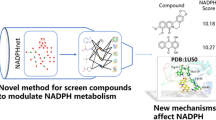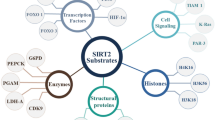Abstract
Aim:
Malic enzymes are oxidative decarboxylases with NAD+ or NAD(P)+ as cofactor that catalyze the conversion of L-malate to pyruvate and CO2. The aim of this study was to discover and characterize a potent inhibitor of human NAD(P)+-dependent malic enzyme 2 (ME2).
Methods:
Recombinant human ME2-His-Tag fusion protein was overexpressed in E coli and purified with Ni-NTA resin. A high-throughput screening (HTS) assay was developed to find ME2 inhibitors. Detergent Brij-35 was used to exclude false positives. The characteristics of the inhibitor were analyzed with enzyme kinetics analysis. A thermal shift assay for ME2 was carried out to verify the binding of the inhibitor with the enzyme.
Results:
An HTS system for discovering ME2 inhibitors was established with a Z′ factor value of 0.775 and a signal-to-noise ratio (S/N) of 9.80. A library containing 12 683 natural products was screened. From 47 hits, NPD387 was identified as an inhibitor of ME2. The primary structure-activity relationship study on NPD387 derivatives showed that one derivative NPD389 was more potent than the parent compound NPD387 (the IC50 of NPD389 was 4.63±0.36 μmol/L or 5.59±0.38 μmol/L, respectively, in the absence or presence of 0.01% Brij-35 in the assay system). The enzyme kinetics analysis showed that NPD389 was a fast-binding uncompetitive inhibitor with respect to the substrate NAD+ and a mixed-type inhibitor with respect to the substrate L-malate.
Conclusion:
NPD389 is a potent ME2 inhibitor that binds to the enzyme in a fast-binding mode, acting as an uncompetitive inhibitor with respect to the substrate NAD+ and a mixed-type inhibitor with respect to the substrate L-malate.
Similar content being viewed by others
Log in or create a free account to read this content
Gain free access to this article, as well as selected content from this journal and more on nature.com
or
References
Hsu RY, Lardy HA . Pigeon liver malic enzyme. II. Isolation, crystallization, and some properties. J Biol Chem 1967; 242: 520–6.
Loeber G, Infante AA, Maurer-Fogy I, Krystek E, Dworkin MB . Human NAD(+)-dependent mitochondrial malic enzyme. cDNA cloning, primary structure, and expression in Escherichia coli. J Biol Chem 1991; 266: 3016–21.
Xu Y, Bhargava G, Wu H, Loeber G, Tong L . Crystal structure of human mitochondrial NAD(P)+-dependent malic enzyme: a new class of oxidative decarboxylases. Structure 1999; 7: R877–89.
Ren JG, Seth P, Everett P, Clish CB, Sukhatme VP . Induction of erythroid differentiation in human erythroleukemia cells by depletion of malic enzyme 2. PLoS One 2010; 5: e12520.
Romero-Garcia S, Lopez-Gonzalez JS, Baez-Viveros JL, Aguilar-Cazares D, Prado-Garcia H . Tumor cell metabolism: an integral view. Cancer Biol Ther 2011; 12: 939–48.
Jiang P, Du W, Mancuso A, Wellen KE, Yang X . Reciprocal regulation of p53 and malic enzymes modulates metabolism and senescence. Nature 2013; 493: 689–93.
Yang Z, Lanks CW, Tong L . Molecular mechanism for the regulation of human mitochondrial NAD(P)+-dependent malic enzyme by ATP and fumarate. Structure 2002; 10: 951–60.
Wasilenko WJ, Marchok AC . Malic enzyme and malate dehydrogenase activities in rat tracheal epithelial cells during the progression of neoplasia. Cancer Lett 1985; 28: 35–42.
Sauer LA, Dauchy RT, Nagel WO, Morris HP . Mitochondrial malic enzymes. Mitochondrial NAD(P)+-dependent malic enzyme activity and malate-dependent pyruvate formation are progression-linked in Morris hepatomas. J Biol Chem 1980; 255: 3844–8.
Hou S, Liu W, Ji D, Zhao ZK . Efficient synthesis of triazole moiety-containing nucleotide analogs and their inhibitory effects on a malic enzyme. Bioorg Med Chem Lett 2011; 21: 1667–9.
Cleland WW . Statistical analysis of enzyme kinetic data. Methods Enzymol 1979; 63: 103–38.
Mondal R, Koev G, Pilot-Matias T, He Y, Ng T, Kati W, et al. Development of a cell-based assay for high-throughput screening of inhibitors against HCV genotypes 1a and 1b in a single well. Antiviral Res 2009; 82: 82–8.
Zhang JH, Chung TD, Oldenburg KR . A simple statistical parameter for use in evaluation and validation of high throughput screening assays. J Biomol Screen 1999; 4: 67–73.
Hung HC, Chien YC, Hsieh JY, Chang GG, Liu GY . Functional roles of ATP-binding residues in the catalytic site of human mitochondrial NAD(P)+-dependent malic enzyme. Biochemistry 2005; 44: 12737–45.
Cornish-Bowden A . Why is uncompetitive inhibition so rare? A possible explanation, with implications for the design of drugs and pesticides. FEBS Lett 1986; 203: 3–6.
Dixon M . The determination of enzyme inhibitor constants. Biochem J 1953; 55: 170–1.
Zhang JH, Chung TD, Oldenburg KR . A simple statistical parameter for use in evaluation and validation of high throughput screening assays. J Biomol Screen 1999; 4: 67–73.
Sui YX, Wu ZJ . Alternative statistical parameter for high-throughput screening assay quality assessment. J Biomol Screen 2007; 12: 229–34.
Zhang XD, Espeseth AS, Johnson EN, Chin J, Gates A, Mitnaul LJ, et al. Integrating experimental and analytic approaches to improve data quality in genome-wide RNAi screens. J Biomol Screen 2008; 13: 378–89.
Zhang XD . A pair of new statistical parameters for quality control in RNA interference high-throughput screening assays. Genomics 2007; 89: 552–61.
Zhang XD . Novel analytic criteria and effective plate designs for quality control in genome-scale RNAi screens. J Biomol Screen 2008; 13: 363–77.
Mondal R, Koev G, Pilot-Matias T, He YP, Ng T, Kati W, et al. Development of a cell-based assay for high-throughput screening of inhibitors against HCV genotypes 1a and 1b in a single well. Antiviral Res 2009; 82: 82–8.
McGovern SL, Helfand BT, Feng B, Shoichet BK . A specific mechanism of nonspecific inhibition. J Med Chem 2003; 46: 4265–72.
Feng BY, Shelat A, Doman TN, Guy RK, Shoichet BK . High-throughput assays for promiscuous inhibitors. Nat Chem Biol 2005; 1: 146–8.
Walters WP, Namchuk M . Designing screens: how to make your hits a hit. Nat Rev Drug Discov 2003; 2: 259–66.
Gan X, Jiang W, Wang W, Hu L . An approach to 3,6-disubstituted 2,5-dioxybenzoquinones via two sequential Suzuki couplings. three-step synthesis of leucomelone. Org Lett 2009; 11: 589–92.
Pantoliano MW, Petrella EC, Kwasnoski JD, Lobanov VS, Myslik J, Graf E, et al.High-density miniaturized thermal shift assays as a general strategy for drug discovery. J Biomol Screen 2001; 6: 429–40.
Lo MC, Aulabaugh A, Jin G, Cowling R, Bard J, Malamas M, et al. Evaluation of fluorescence-based thermal shift assays for hit identification in drug discovery. Anal Biochem 2004; 332: 153–9.
Acknowledgements
This work was supported by the National Natural Science Foundation of China (81125023 and 81021062), the National Science and Technology Major Projects for Major New Drugs Innovation and Development (2013ZX09507002), and the Shanghai Commission of Science and Technology (11DZ2292200 and 13DZ2290300). We also thank Yan-yun FU and Bei-ying QIU for their help in editing the manuscript.
Author information
Authors and Affiliations
Corresponding authors
Rights and permissions
About this article
Cite this article
Wen, Y., Xu, L., Chen, Fl. et al. Discovery of a novel inhibitor of NAD(P)+-dependent malic enzyme (ME2) by high-throughput screening. Acta Pharmacol Sin 35, 674–684 (2014). https://doi.org/10.1038/aps.2013.189
Received:
Accepted:
Published:
Issue date:
DOI: https://doi.org/10.1038/aps.2013.189
Keywords
This article is cited by
-
NADPH homeostasis in cancer: functions, mechanisms and therapeutic implications
Signal Transduction and Targeted Therapy (2020)
-
Identification of small molecule inhibitors targeting the SMARCA2 bromodomain from a high-throughput screening assay
Acta Pharmacologica Sinica (2018)
-
Inhibition of malic enzyme 1 disrupts cellular metabolism and leads to vulnerability in cancer cells in glucose-restricted conditions
Oncogenesis (2017)


